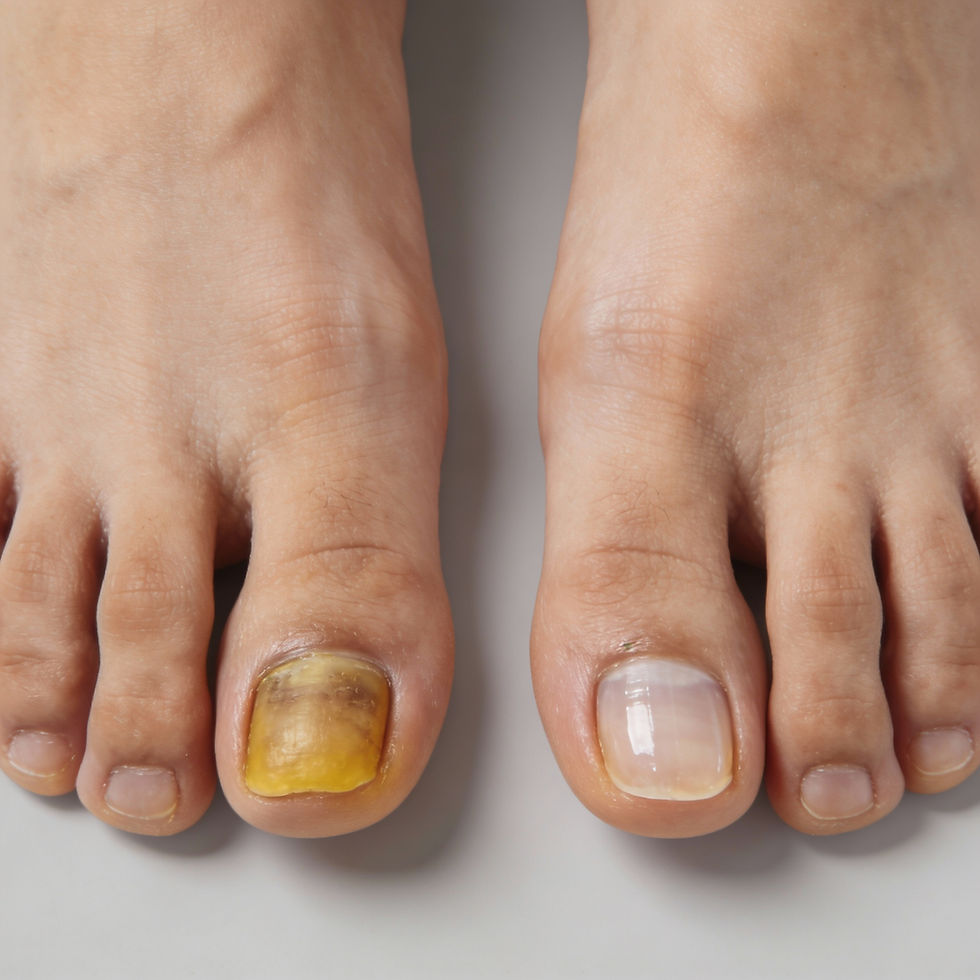Oxidative Stress and Its Impact on Foot and Ankle Health
- Dr. Cynthia

- May 27
- 4 min read
Oxidative stress is not only a systemic concern but also plays a critical role in the health of specific body regions, such as the feet and ankles. With the lower extremities being essential to mobility and bearing much of our body weight, they are especially vulnerable to damage from oxidative stress. Let’s dive into how oxidative stress impacts foot and ankle health, its role in specific foot-related conditions, and strategies to mitigate its effects.

Understanding Oxidative Stress in Relation to Foot and Ankle Health
Oxidative stress arises when there’s an imbalance between free radicals—highly reactive molecules that damage cells—and antioxidants, which neutralize these radicals. Since the feet and ankles have high demands placed on them through movement and weight-bearing, the cells in this area can be particularly vulnerable to oxidative damage, impacting joint health, blood flow, and tissue integrity.

How Oxidative Stress Affects the Feet and Ankles
Oxidative stress in the lower extremities contributes to various foot and ankle issues, especially as it can:
Weaken Joint and Connective Tissue: Free radicals can damage the collagen and elastin in joint cartilage and ligaments, making the joints in the ankles and feet more susceptible to wear and tear.
Reduce Blood Flow: The blood vessels in the lower extremities are prone to oxidative damage, which can impair circulation. This is particularly significant for individuals with conditions like diabetes, where blood flow to the feet is already compromised.
Delay Healing: For injuries like sprains or fractures, oxidative stress can slow down the healing process by damaging cell membranes and reducing cell viability, prolonging recovery times.
Specific Foot and Ankle Conditions Linked to Oxidative Stress
Diabetic Foot Complications: Diabetic neuropathy, peripheral artery disease, and foot ulcers are often exacerbated by oxidative stress. High blood sugar levels generate excess free radicals, leading to damage in blood vessels and nerves in the feet, which compromises sensation, healing, and circulation.
Plantar Fasciitis: As a common cause of heel pain, plantar fasciitis involves inflammation of the plantar fascia. Oxidative stress can exacerbate inflammation, potentially worsening pain and delaying the recovery of the ligamentous tissue.
Osteoarthritis: Oxidative stress contributes to cartilage degradation, a hallmark of osteoarthritis. As cartilage in the ankle joints deteriorates, patients experience pain, stiffness, and decreased mobility.
Gout: An inflammatory condition often affecting the feet, gout is aggravated by oxidative stress. Free radicals can intensify inflammation in joints, worsening the pain and swelling associated with gout attacks.
Measuring Oxidative Stress for Foot and Ankle Health
One way to evaluate oxidative stress in relation to foot and ankle health is through urinary 8-hydroxy-2'-deoxyguanosine (8-hydroxy DG) testing, which detects oxidative damage to DNA. Elevated levels of 8-hydroxy DG indicate that oxidative stress may be affecting cellular health, potentially contributing to foot and ankle issues, especially in individuals with diabetes or circulatory problems. By identifying oxidative stress early, you can work to mitigate its impact on foot and ankle function.
Nutritional and Antioxidant Support for Foot and Ankle Health
Managing oxidative stress is key to protecting the feet and ankles from long-term damage. Certain nutrients and supplements can support cellular resilience in these regions:
Glutathione (Reduced): Known as the body’s master antioxidant, glutathione helps combat oxidative stress. A dose of 100 mg, taken twice daily, can help reduce cellular damage in the feet and ankles.
Alpha-Lipoic Acid: Particularly helpful for diabetic neuropathy, alpha-lipoic acid is both water- and fat-soluble, allowing it to penetrate nerve tissues and support foot nerve health. A daily dosage of 200-600 mg is recommended, depending on personal health factors.
Berberine: This powerful antioxidant supports blood sugar control, which helps reduce oxidative damage in diabetic patients, particularly those with neuropathy or circulation issues affecting the feet.
Integrating Foot and Ankle Health into Functional Medicine
In functional medicine, foot and ankle health assessments can complement evaluations of oxidative stress. For example, oxidative stress testing can reveal systemic inflammation, while assessing adrenal health, nutrient status, and blood glucose can provide further insight into factors that impact foot and ankle function. Identifying oxidative stress and its root causes allows healthcare providers to design personalized treatment plans that address inflammation, circulation, and tissue health in the lower extremities.
Practical Tips for Supporting Foot and Ankle Health Through Antioxidant-Rich Lifestyle Choices
In addition to targeted supplements, lifestyle choices can help manage oxidative stress and protect foot and ankle health:
Consume Antioxidant-Rich Foods: Berries, leafy greens, nuts, and seeds are high in antioxidants that combat free radicals.
Regular Physical Activity: Low-impact activities like walking, swimming, and cycling promote blood flow to the feet and ankles without adding strain.
Foot Care for Diabetics: People with diabetes should regularly check their feet, wear supportive footwear, and manage blood sugar to reduce the risk of oxidative damage and complications.
Conclusion
Oxidative stress significantly impacts foot and ankle health, contributing to conditions like plantar fasciitis, diabetic neuropathy, and arthritis. By understanding oxidative stress and taking proactive steps to manage it, we can protect foot and ankle health, prevent long-term damage, and enhance overall quality of life. For those with foot health concerns, consider discussing oxidative stress testing and antioxidant strategies with a healthcare provider to support lower extremity resilience and function.




Comments